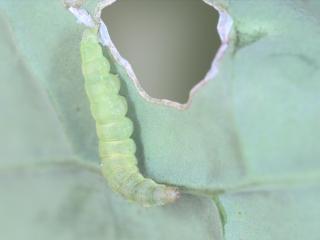Diamondback moth caterpillars
- Merredin
Jessica Smith (DKT Rural Agencies) has reported finding 21-50 diamondback moths (DBM) per 10 sweeps in a late flowering Bonito canola crop near Merredin. Jessica commented that there are lots of DBM around now and numbers have increased from five caterpillars in 10 sweeps two weeks ago to 25 in 10 sweeps now.
This is the first report of DBM caterpillars reported to PestFax so far this year. DPIRD entomologists this week inspected many canola crops in the Northam, Toodyay and Goomalling areas with no DBM caterpillars found.
Growers and consultants are advised that now is the time to monitor crops for DBM by doing at least four lots of 10 sweeps with an insect sweep net at various locations in canola crops. Past GRDC funded department research into DBM outbreaks has indicated that July to August is a critical time of year to monitor caterpillar numbers as it assists with foreseeing possible damaging spring populations.
Thresholds for control are:
- Early to mid-flowering (no stress) - 50 grubs or more per 10 sweeps
- Mid to late flowering (no stress) - 100 or more grubs per 10 sweeps
- Pod maturation - 200 or more grubs per 10 sweeps.
DBM caterpillars drop from plants when disturbed and bashing some plants, especially those with holes in leaves, over an ice cream container is a good initial indication of their presence if you don’t have a sweep net handy.
For more information refer to;
- DPIRD’s 2018 PestFax Issue 17 article Are you monitoring for diamondback moth caterpillars in your canola?
- DPIRD’s Diagnosing diamondback moth page
- GRDC's Diamondback moth fact sheet.
For more insect information contact Dustin Severtson, Development Officer, Northam on +61 (0)8 9690 2160 or Alan Lord, Technical Officer, South Perth on +61 (0)8 9368 3758 or Svetlana Micic, Research Officer, Albany on +61 (0)8 9892 8591.

